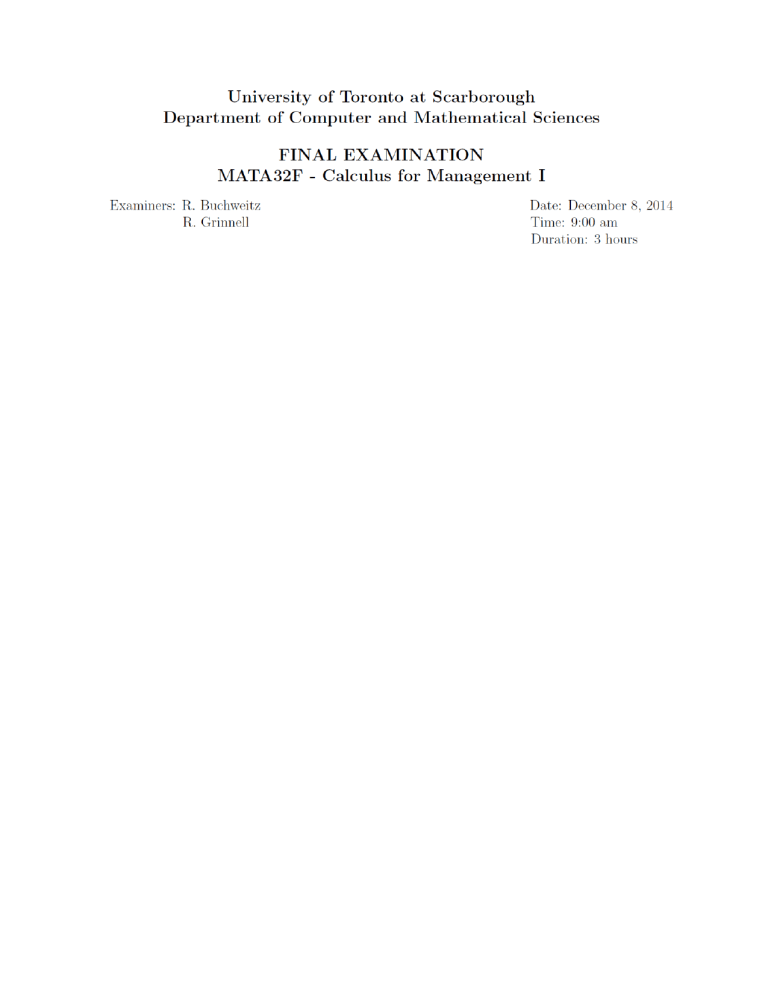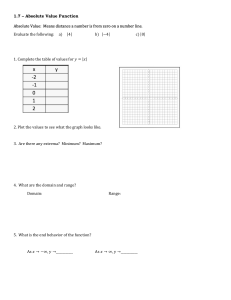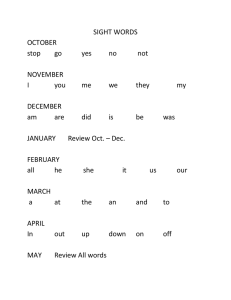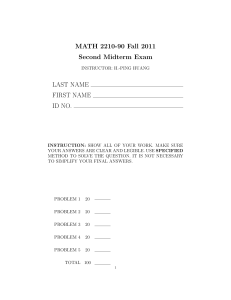
The following may be helpful η= S = P (1 + r ) n p/q dpdq re = 1 + ∑kn=1 k = r n n S = R n(n+1) 2 (1+r )n -1 r A = R ∑nk =1 k2 = 1-(1=r )-n r n(n+1) (2 n+1) 6 Part A: (Multiple Choice questions). For each of the following, clearly print the letter of the answer you think is most correct in the boxes on the first page. Each right answer earns 3 points and no answer / wrong answers earn 0 points. No justification is required. 1. If h' (x) = 2 x + 7 and h(1) = 8 then h(-3) equals 2 3 (a) -28 3 (b) h(x) = ∫ h' (x) dx = ∫ 2 x + 7 dx = h ( x) = 1 (2 x+7) 3 2 h (1 ) = 8 = h ( x) = 1 3 2 1 3 3 2 +C= 3 (a) 4 xu-3 = 1 2 -2 4 x2 + 1 -2 3 1 ∫ 2 x + 7 (2 x + 7 ) (2 x + 7 ) + C ⟶ ⟶ (2 x + 7 ) - 1 3 2 1 2 3 2 (9 ) 2 + C = 9 + C 2. If u = -4 x2 + 1 du dx 1 3 then (d) - (c) 16 C = -1 h(-3) = · 1 2 - 1 = du dx 1 3 equals (b) -4 xu3 (8 x) = 4 x 4 x2 + 1 -2 3 3 2 (e) none of (a) - (d) 3 2 3 (c) 2 xu-3 (d) 4 xu- 2 3 = -4 x-4 x2 + 1 2 = -4 xu3 - 1 3 (e) -4 xu-3 3. Given the effective rate re , the equivalent nominal rate of r compounding quarterly is given by (a) 4 4 1 + re (1 + re ) = 1 + r 4 4 (b) 3 ^1/4 1 + r 4 4 1 + re - 1 = (1 + re ) 4 ⟶ 1 (c) 4 r =4 4 4 1 + re - 1 1 + re - 1 (d) 4 4 1 + re + 1 2 2014_Dec 8 4. The area of the region bounded by x-axes and the curve y = x2 - 3 x is 9 2 (a) (b) 3 (c) A = ∫0 x2 - 3 x dx = 3 x3 - 3 · 2 x2 3 1 1 A = · 3 3 - · 33 = - · 33 = 1 3 1 2 1 6 (d) - (e) 9 19 2 27 4 2 (e) none of (a) - (e) 3 0 9 2 5. If p = -3 q + 150 is a demand function where the quantity q satisfies 0 < q < 50, then we have unit elasticity at (a) q = 48 (b) q = 30 (c) q = 25 (d) q = 5 (e) a value of q not in (a) - (d) (f) no value of q η= p q dp dq p q = -3 + dp 150 q dq Unit elasticity occurs at η = 1: 50 q > 1 for 0 < q < 50 ⟶ η 50 q ⟶ =2 q = 25 = =-3 1- 1- 50 q η= 50 q = -1 - -3+ = 150 q -3 =1- 1- 50 q -1 - 50 =1 q 50 q 50 q 1 ≥ 50 q 1 < 50 q 6. If a < 0 is a constant and f (x) = xe- a then we may conclude that f has a (a) local maximum at x = a (b) local minimum at x = a (c) local maximum at x = -a (d) local minimum at x = -a x f ' (x) = e- a + xe- a - = e- a 1 - = 0 ⟶ x x 1 a x x a f '' (x) = - e 1 - + e - = - e 1 f 1 a 1 '' (x) = a x -a e 2 x -a x a x a x -a 1 a x -a 1 a x a x = a is a critical point. + 1 f '' (a) = - e-1 (2 - 1) = - > 0 for a < 0 1 a 1 a which means that f has a local minimum at x = a 7. The exact value of ∫1 e2 [ln (x)]2 e -1 6 6 (a) I = ∫1 e2 (ln x)2 (b) dx = i = 2 · 3 (ln x)3 I= 1 8 6 1 = 2x 4 3 4 3 2x dx is (c) 1 1 1 2 ∫ (ln x) d (ln x) 2 0 1 1 to e2 = 6 (2 ln e)3 (d) - 0 8 3 (e) e6 -1 3 (f) none of (a) - (e) 2014_Dec 8 3 8. Assume your annual salary increases by a fixed percentage at the end of each year and that it takes eight years for your salary to double. The percentage rate r (as a decimal) of your annual salary increase is given by (a) 2 8 - 1 (b) 8 ln 2 - 1 1 S1 + = 2 S r 8 8 (c) e 1 + = 2 8 r 8 ⟶ 1 r = 8 2 8 - 1 1 1 9. If y = 2 (5x ) and n is a positive integer, then y (n) (1) equals (a) 10 (ln 5)-n (b) (2 ln 5)· 5 n (c) (10 ln 5)· n y = 2 · 5x y ' = 2 · 5x ln 5 y '' = 2 · 5x (ln 5)2 y ''' = 2 · 5x (ln 5)3 ... y (n) = 2 · 5x (ln 5)n (d) 8 2 8 - 1 ln 2 8 (d) 10 ln (5n ) y (n) (1) = 10 (ln 5)n 10. Exactly how many of the following statements are always true? (a) 0 (b) 1 (c) 2 (d) 3 (i) (ii) (iii) (iv) (e) 10 (ln 5)n (e) 4 If f is continuous at 0, and ∫-1 f (x) dx > 0, then is differentiable at 0 1 ⟶ FALSE (for instance: f (x) = x s not differentiable at x = 0). The defInite integral of a continuous function h over [a, b] is a function H such b that ∫a h (x) dx = H (b) - H (a) ⟶ FALSE (The definite integral is a number, not a function!). A continuous function g has a local minimum at a number c if and only if c is a critical number of h ⟶ FALSE (h '' (c) > 0 is also a prerequisite). If a is a critical number of a polynomial, then the 2nd derivative test is always preferable over the 1st derivative test when checking for extrema at a ⟶ TRUE (Because f '' (x) is always a lower grade polynomial then f ' (x)). 4 2014_Dec 8 Part B: (Full-Solutions Questions). Write clear solutions in the spaces provided. Full points will be awarded only if your solutions are correct, complete and sufficiently display appropriate concepts from MATA32. 1. The parts of this question are independent of each other. (a) Find the exact value of y ' (1) where y = y' = 1 x2 + 3 4 x3 ex+x + x4 ex+x (1 + 2 x) 2 2 y ' (1) = 4 4 e2 + 3 e2 · 2 - e2 · 2 = 1 1 27 8 x4 ex+x 2 x +3 (8 points) 2 x 2 + 3 - x 4 e x+ x · 2 e2 ≈ 94.94 2x 2 x2 + 3 (b) Find the qubic polynomial y = Q(x) having all these properties: Q(1) = 31, Q ' (1) = 7, Q'' (1) = 24, and Q ''' (1) = 24 Q(x) = ax3 + bx2 + cx + d Q(1) = 31 = a + b + c + d a + b + c + d = 31 Q ' (x) = 3 ax2 + 2 bx + c Q ' (1 ) = 7 = 3 a + 2 b + c Q ''' (x) = 6 a Q ''' (1) = 24 = 6 a (4) (3) (2) (1) ⟶ ⟶ ⟶ ⟶ a=4 6 · 4 + 2 b = 24 3·4 + 0 + c = 7 4 + 0 - 5 + d = 31 Q(x) = 4 x3 - 5 x + 32 Check: ... (1) 3a+2b+c=7 Q '' (x) = 6 ax + 2 b Q '' (1) = 24 = 6 a + 2 b 6 a + 2 b = 24 ⟶ ⟶ ⟶ b=0 c = -5 d = 32 6 a = 24 Q' (x) = 12 x2 - 5, Q(x) = 4 x3 - 5 x + 32 Q ' (x) = 12 x2 - 5 Q'' (x) = 24 x Q ''' (x) = 24 ... , (8 points) ... ... (2) (3) (4) Q ''' (x) = 24) Q(1) = 4 - 5 + 32 = 31 ✓ Q ' (1) = 12 · 1 - 5 = 7 ✓ Q '' (1) = 24 · 1 = 24 ✓ Q ''' (1) = 24 ✓, 2014_Dec 8 2. The parts of this question are independent of each other. (a) Find the absolute extrema of the function f (x) = x3 - 12 x + 1, where x ϵ [-1, 3] and state where these extrema occur. Sufficiently justify your answer. (8 points) f ' (x) = 3 x2 - 12 = 3 x2 - 4 = 0 x = 2 is a critical point (x = -2 out of the interval and ignored), f '' (x) = 6 x f '' (2) = 6 · 2 > 0 f (x) has a local minimum at the point (2, f (2)) i.e. at (2, -15) f (2) = 8 - 24 + 1 = -15 Now, we check value of f (x) at both ends on the interval x ϵ [-1, 3]: f (-1) = (-1)3 - 12 (-1) + 1 = 12 f (3) = 33 - 12 · 3 + 1 = -8 We summarize results of the calculation in the table below: Left end Critical point Right end 2 3 -1 12 - 15 -8 x f (x) Function f (x) has an absolute maximum fmax = 12 at x = -1 (at left end of the interval) and an absolute minimum fmin = -15 at x = 2 (at critical point) (b) Find x =t I=2 1 2 x 1 x x+2 a dx = dt t 2 +2 at+a2 1 x +a2 · dt = 2 ∫ 1 dx where a > 0 is a constant. (t +a)2 x = t2 dt = -2 · 1 t +a =- 2 x +a +C (7 points) 5 6 2014_Dec 8 3. In all of this question let q > 0 represent quantity (i.e. number of units) and p > 0 represent unit price (i.e. price per unit). Assume a demand function p = 50 and an average cost function c(q) = (a) Given that “profit = revenue - cost”, find the profit function, F (q). F (q ) = R (q ) - C (q ) C (q ) = c (q ) · q = + F (q) = 50 1 4 1 - 4 q 100 1 ·q = q 4 q R (q ) = p · q = q + 100 q + 100 = 50 q - 1 4 50 q q = 50 1 4 + 100 . q (4 points) q q - 100 (b) Find the value of q that maximizes total profit and state the maximum profit. Sufficiently justify that your value actually maximizes the total profit function. (9 points) F ' (q ) = 50 2 q - 1 4 =0 ⟶ q = 25 · 4 = 102 q = 104 = 10, 000 Maximum total profit occurs when 10,000 units are produced: F (10 000) = 50 · 100 F ' (q) = 25 q- 2 1 10 000 4 1 4 - 100 = $2, 400, . F '' (q) = 25 3 -1 q- 2 2 <0 ⟶ F (10 000) = $2, 400 = Fmax (c) Verify that “marginal revenue” = “marginal cost” at the value of q that maximizes total profit. (3 points) (i) Marginal revenue: (ii) Marginal cost: dC dq dR dq = 50 = q + 100 ' = 1 4 q ' = 50 · 1 4 .1 2 q = 50 2·100 Q.E.D. = 1 4 2014_Dec 8 7 4. (a) Give a good, labelled sketch of the region R that is bounded by the two curves x = y 2 + 1 and x = -(y - 1)2 and the two lines y = -1 and y = 1. (b) Find the area of R. dA = (x1 - x2 )· dy (8 points) A = ∫ (x1 - x2 )· dy 1 1 2 A = ∫-1 y + 1 - -(y - 1)2 dy = ∫-1 2 y 2 1 1 A = 2 · y 3 - 2 · y 2 + 2 y (-1 to 1) 3 2 2 2 4 A = - 1 + 2 - - - 1 - 2 = + 4 3 3 3 16 A= 3 - 2 y + 2 dy (5 points) 8 2014_Dec 8 5. Evaluate the following two definite integrals: (a) ∫0 x3 1 4 1 + 15 x4 dx 1 + 15 x4 = t I= I= 1 16 1 ∫ t4 60 1 1 75 dt = 1 60 16 4 - 1 = 5 · (7 points) x=0 ⟶ t=1 60 x3 dx = dt 1 5 4 (1 to 16) 5 t4 31 75 (b) ∫0 2 xe-3 x dx. 2 Simplify your answer as much as you can. By Integration by parts: u = 2 x ⟶ du = 2 dx and I = uv - ∫ vdu = - xe-3 x - ∫ - e-3 x 2 dx I = - xe-3 x + 2 1 (3 3 2 1 = 3 e-3 x -x - 3 2 = - (3 x + 1 ) e -3 x 9 2 = - 7 e-6 - 1 9 2 3 I I I 2 3 I= 2 9 1 - and e -3 x ) 1 3 (0 to 2) 2 e6 -7 7 = ≈0.2184 6 e 9 e6 x = 1 ⟶ t = 16 (9 points) e-3 x dx = dv ⟶ - 3 e-3 x = v 1 2014_Dec 8 6. In all of this question ;let y = h(x) = x4 + 2 x3 - 1 (a) Find the intervals where h is (i) increasing/decreasing and (ii) concave up/down. (i) y ' = 4 x3 + 6 x2 = 0 2 x2 (2 x + 3 ) = 0 Sign of y ' depends on the (2 x + 3) part: ⟶ x1 = x2 = 0 and x3 = - 2 x + 3 ≷ 0 for x ≷ - 9 (6 points) 3 2 3 2 h(x) is increasing for x > - 2 , i.e. on - 2 , ∞ and is decreasing for x < - 2 , i.e on (-∞,- 2 . 3 3 3 3 (ii) y '' = 12 x2 + 12 x is a parabola with roots at x = -1 and x = 0 and the gtraph comes handy : We conclude that: and that: y '' > 0 for x < -1 & x > 0 y '' < 0 for -1 < x < 0 ⟶ ⟶ h(x) is concave up on (-∞,-1) and (0, ∞) h(x) is concave down on (-1, 0) (b) Find all relative extrema and point(s) of inflection of h. Sufficiently justify your answer. (4 points) (i) Local extrema: As shown in (a) above, critical points of h(x) are at x = 0 and x = - . y '' = 12 x2 + 12 x = 12 x(x + 1) (y '' (0) = 0, meaning that x = y '' - 2 = 12 - 2 - 2 + 1 = 9 > 0 3 3 3 3 2 3 2 is the only local extrema). ⟶ h(x) has a local minimum at x = - 2 3 h- = - + 2 - - 1 ≈ -2.7 ⟶ Local minimum is at the point (-1.5, -2.7) 3 2 (ii) 3 4 2 3 3 2 Inflection point: y '' = 12 x(x + 1) = 0, means that there are two inflection points: x = 0, h(0) = -1 ⟶ and (0, -1), ⟶ x = -1, h(-1) = 1 - 2 - 1 = -2 (-1, -2). (c) Give an accurate , labeled sketch of the graph y = h(x). Be sure to include all features you found in Parts (a) and (b) . (6 points) 10 2014_Dec 8 7. A square sheet of cardboard of side length a is used to make an open box by cutting equal squares from four corners and folding up the sides. What size squares (in terms of a) should be cut out of the corners to obtain a box of maximum possible volume? What is the maximum possible volume (in terms of a)? Show all work and justification in your solution. (13 points) (a - 2 x ) x (a - 2 x ) (a - 2 x ) V = (a - 2 x)2 · x = a2 - 4 ax + 4 x2 · x V = 4 x3 - 4 ax2 + a2 x V ' = 12 x2 - 8 ax + a2 V ' = 12 x2 - 6 ax - 2 ax + a2 V ' = 6 x(2 x - a ) - a (2 x - a ) V ' = (6 x - a ) (2 x - a ) = 0 ⟶ x= 1 6 a (there’s no box for x = a cut!) 1 2 Proving that this x-cut yields to the maximum volume: V '' = 24 x - 8 a = 8 (3 x - a) Vmax = a - 2 · a · a = · a3 1 6 Vmax = 2 27 2 1 6 2 2 1 3 6 V '' a = 8 - 1 a = -4 a < 0 1 6 3 6 ⟶ V a = Vmax 1 6 a3 = 2 (interesting: exactly 2 x volume of the small cube with side of a / 3!) a 3 3 2014_Dec 8 11 8. The parts of this question are independent from each other. (a) Find the equation of the tangent line to the curve y = x3 - 3 x2 + 5 x that has the smallest possible slope. Give your answer in “slope-intercept” form. Sufficiently justify your work. (8 points) Equation of the tangent line in its general form is y - y0 = m(x - xo ) where (x0, y0 ) is a point of tangency and m = y ' (x0 ). y ' = g(x) = 3 x2 - 6 x + 5. To determine the minimum possible slope we look for the minimum value of g(x), i.e. for its critical point: g ' (x) = 6 x - 6 = 0 ⟶ x = 1 and f (1) = 13 - 3· 12 + 5· 1 = 3. Check: g'' (x) = 6 > 0, meaning that g(1) = m = 3 - 6 + 5 = 2 is the minimum value of the slope. We conclude that given curve will have the tangent with the smallest possible slope at point of tangency (x0 , y0 ) = (1, 3). For the equation of the tangent, with (x0 , y0 ) = (1, 3) and m = 2, we get: y - 3 = 2 (x - 1) From the graph shown below, given just as an illustration and not required to be included in the answer, it can be concluded that a tangent at any other point then at (1, 3) would have a bigger slope indeed! (b) Let S represent the amount of an ordinary annuity as a function of n, the number of compounding periods. Show that dS/dn = α(K + S), where K = R/r and α = ln(1 + r). (7 points) S = R (1+r )n -1 R = [(1 + r )n r r ⟶ - 1] S = K [(1 + r )n - 1] ... (1) ( Derivative of an exponential function: y = ax y ' = ax ln a) dS dn = K (1 + r )n ln(1 + r ) = Kα (1 + r )n (1) (1 + r )n = (2) dS dn = Kα S K +S +1= K K K +S = α(K + S) K ⟶ Q.E.D. dS dn = Kα (1 + r )n ... (2)


